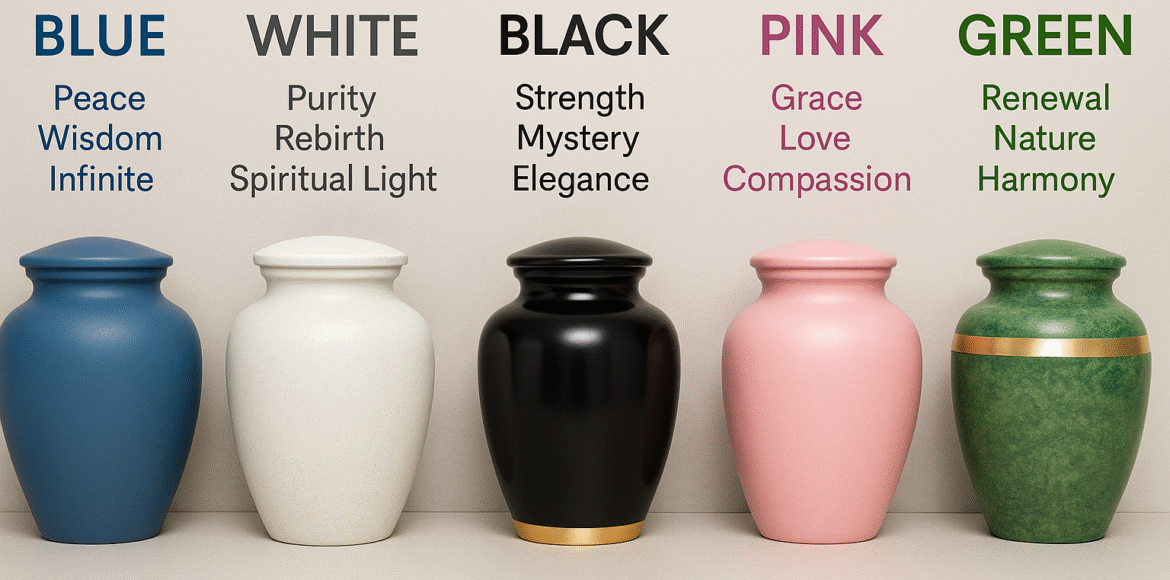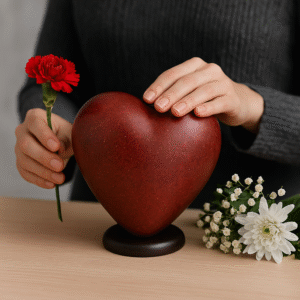The Significance of 1 Urn Colors in Cremation

In the world of cremation, families often find themselves focused on practical decisions: urn size, material, engraving. But one powerful detail is often overlooked—color.
Believe it or not, the color of an urn isn’t just aesthetic. Across cultures, psychology, and history, color has symbolized grief, rebirth, strength, purity, or even eternal love. When choosing an urn, the shade you select could speak volumes—without you ever realizing it.
So, what does your urn’s color say about your loved one? Or about how you choose to remember them?

Color Psychology Meets Mourning Rituals
Colors have long played a role in rituals of grief and remembrance. Carl Jung believed colors spoke to the subconscious mind. Modern therapists use color psychology to treat emotional imbalances. In mourning, color becomes more than decoration—it becomes memory, emotion, and healing.
Blue: Peace, Wisdom, and the Infinite
Blue is often the most chosen urn color, and for good reason. It represents serenity, trust, and the infinite sky or sea. A deep navy urn might suggest a soul that was calm, reflective, or wise beyond their years. In Hindu tradition, blue is the color of Lord Krishna—divine, eternal, and playful.
Best for: Philosophers, peacemakers, and those who loved nature or water.
White: Purity, Rebirth, and Spiritual Light
White is universally seen as a symbol of purity, innocence, and transition. In Buddhism and Eastern cultures, white is the traditional color of mourning, representing a peaceful passing into the next life. A white marble urn is often chosen for children or spiritual individuals.
Best for: Infants, spiritual leaders, or anyone whose light shone quietly but brightly.
Black: Strength, Mystery, and Elegance
In Western cultures, black is the most traditional mourning color—sombre, powerful, and final. A black urn carries a weight of dignity and timelessness, especially when paired with metallic accents like silver or gold. It represents someone who was bold, grounded, or deeply private.
Best for: Artists, introverts, leaders—those with gravity and mystery.
Pink or Lavender: Grace, Love, and Compassion
Pastel tones such as pink or lavender are gentle and emotional. These urns often reflect tenderness, compassion, and unconditional love. In some Victorian mourning customs, flowers like lavender symbolized remembrance. Pink also reflects healing from grief in color therapy.
Best for: Mothers, daughters, caretakers—or anyone remembered for their gentle heart.
Gold: Eternity, Honor, and Divine Light
Gold isn’t just flashy—it’s spiritual. In many religions, gold symbolizes eternity, enlightenment, and divine connection. A gold urn is often chosen for someone deeply respected or whose life left a lasting legacy. In Ancient Egypt, gold was seen as the skin of the gods.
Best for: Patriarchs, mentors, or anyone who shined in life and continues to inspire in death.
Green: Renewal, Nature, and Harmony
Green represents life, nature, and harmony. For eco-conscious families or nature lovers, a green urn—especially a biodegradable one—can symbolize return to the earth. It’s also considered healing in many indigenous traditions and is used in Islamic art as a symbol of paradise.
Best for: Environmentalists, gardeners, or souls who brought balance and peace.

Red: Passion, Strength, and Devotion
Red might feel like an unusual choice, but in Chinese funerary customs, it’s associated with joy and celebration of a long life. In the West, it reflects passion, courage, and deep emotion. A red urn may be chosen to honor a fiery, fearless personality.
Best for: Warriors, activists, or loved ones with larger-than-life spirits.
Multicolored or Custom Art Urns: Unique Lives, Unique Stories
Some families opt for hand-painted or artistic urns featuring a spectrum of colors—each representing a chapter of the loved one’s life. These are especially common in modern Western funerals or among creative individuals.
Think of it as a canvas of memories—not confined by rules, but expressive of individuality.
Cultural Clashes and Cautions
Be mindful: color symbolism isn’t universal.
-
White may mean purity in the U.S., but mourning in India.
-
Red may symbolize love in the West, but bad luck in traditional funerals elsewhere.
If you’re honoring mixed cultural roots, consider combining tones or choosing neutral hues.

what to know before buying the urns in USA
Final Tip: Let the Color Reflect the Life
Don’t feel pressured by trends or taboos. When selecting an urn color, ask yourself:
“What color did they wear often?”
“Which shade reminds me most of them?”
“What feeling do I want to hold onto?”
Whether it’s a sky-blue urn for a dreamer, or an earthy green for a nature lover—your choice is a message to memory itself.
